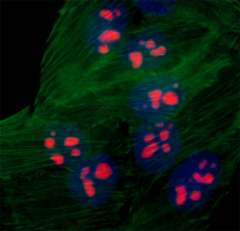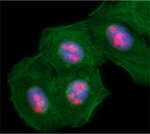- Clone
- P87H10B9 (See other available formats)
- Regulatory Status
- RUO
- Other Names
- NPM, Nucleolar phosphoprotein B23, Nucleolar protein NO38, Numatrin
- Isotype
- Mouse IgG1, κ
- Ave. Rating
- Submit a Review
- Product Citations
- publications

-

HeLa cells were fixed with 4% paraformaldehyde (PFA) for 15 minutes, permeabilized with 0.5% Triton X-100 for three minutes, and blocked with 5% FBS for 60 minutes. The cells were intracellularly stained with 1 µg/ml Alexa Fluor® 594 anti-Nucleophosmin antibody (clone P87H10B9) overnight at 4°C. Actin filaments were labeled with Alexa Fluor® 488 Phalloidin (green). Nuclei were counterstained with DAPI (blue). The image was captured with a 60X objective.
| Cat # | Size | Price | Quantity Check Availability | Save | ||
|---|---|---|---|---|---|---|
| 686803 | 25 µg | £109 | ||||
Nucleophosmin is a member of the nucleophosmin/nucleoplasmin family that shuttles between the nucleus and cytoplasm. This protein regulates the stability and transcriptional activity of p53 and acts as a molecular chaperone. It preferentially binds to denatured proteins and has been shown to stimulate DNA polymerase activity and control the duplication of centrosomes. The chaperone activity of nucleophosmin is regulated by protein kinase CK2 and promotes the release of denatured substrates from nucleophosmin. It is modified by phosphorylation on Thr199. This protein has been shown to bind to RNA and DNA and interact with nucleolar proteins including nucleolin, protein P120, HIV-1 Rev protein, and hepatitis delta antigens.
Product DetailsProduct Details
- Verified Reactivity
- Human
- Antibody Type
- Monoclonal
- Host Species
- Mouse
- Immunogen
- Purified recombinant human nucleophosmin (2-265 a.a.) expressed in E. coli.
- Formulation
- Phosphate-buffered solution, pH 7.2, containing 0.09% sodium azide.
- Preparation
- The antibody was purified by affinity chromatography and conjugated with Alexa Fluor® 594 under optimal conditions.
- Concentration
- 0.5 mg/ml
- Storage & Handling
- The antibody solution should be stored undiluted between 2°C and 8°C, and protected from prolonged exposure to light. Do not freeze.
- Application
-
ICC - Quality tested
- Recommended Usage
-
Each lot of this antibody is quality control tested by immunocytochemistry. For immunocytochemistry, a concentration range of 0.2 - 1.0 μg/ml is recommended. It is recommended that the reagent be titrated for optimal performance for each application.
* Alexa Fluor® 594 has an excitation maximum of 590 nm, and a maximum emission of 617 nm.
Alexa Fluor® and Pacific Blue™ are trademarks of Life Technologies Corporation.
View full statement regarding label licenses - RRID
-
AB_2617022 (BioLegend Cat. No. 686803)
Antigen Details
- Structure
- 294 amino acids with a predicted molecular weight of 33 kD.
- Distribution
-
Nucleolus.
- Function
- Involved in ribosome biogenesis, centrosome duplication, protein chaperoning, histone assembly, cell proliferation, and regulation of tumor suppressors p53/TP53 and ARF.
- Interaction
- NSUN2, SENP3, hepatitis delta virus S-HDAg, HTLV1 Rex protein, methylated form of RPS10, APEX1, NEK2, ROCK2 and BRCA2, RPGR, CENPW, EIF2AK2/PKR, CEBPA (isoform 4), and DDX31.
- Biology Area
- Cell Biology
- Molecular Family
- Phospho-Proteins
- Antigen References
-
1. Szebeni A, et al. 2003. J. Biol. Chem. 278:9107.
2. Colombo E, et al. 2002. Nat. Cell Biol. 4:529.
3. Chan PK, et al. 1986. J. Biol. Chem. 261:14335. - Gene ID
- 4869 View all products for this Gene ID
- UniProt
- View information about Nucleophosmin on UniProt.org
Related Pages & Pathways
Pages
Related FAQs
Other Formats
View All Nucleophosmin Reagents Request Custom Conjugation| Description | Clone | Applications |
|---|---|---|
| Purified anti-Nucleophosmin | P87H10B9 | WB,ICC |
| Alexa Fluor® 594 anti-Nucleophosmin | P87H10B9 | ICC |
Compare Data Across All Formats
This data display is provided for general comparisons between formats.
Your actual data may vary due to variations in samples, target cells, instruments and their settings, staining conditions, and other factors.
If you need assistance with selecting the best format contact our expert technical support team.
-
Purified anti-Nucleophosmin
Total cell lysate from NIH3T3 cells (lane 1, 15 µg) and HeLa... 
HeLa cells were fixed with 2% paraformaldehyde (PFA) for 15 ... 
Whole cell extracts (15 µg total protein) from Daudi, ... -
Alexa Fluor® 594 anti-Nucleophosmin

HeLa cells were fixed with 4% paraformaldehyde (PFA) for 15 ...
 Login / Register
Login / Register 














Follow Us